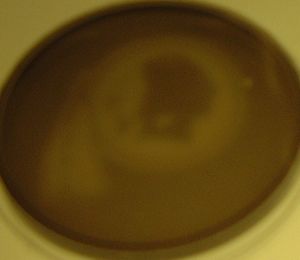20.109(F09): Mod 2 Day 1 Testing an engineered biological system
Testing an engineered biological system
Introduction
Why engineer biological systems
Two Component Signaling Systems
Bacteria as pixels
E. coli do not normally respond to light but a recent publication describes a combination of genes that lead to light-responsive expression of beta-galactosidase in E. coli. When the cells are grown in the dark, transcription of lacZ is high and the indicator in the media turns black. When the cells are grown in the light, there is very little transcription of the lacZ gene and the media’s natural color (yellowish) shows through.


B-gal as readout
For today, you can get used to this system with a few simple tests. You’ll plate a layer of cells on indicator medium in two dishes, and then incubate one dish in the light and the other in the dark until next time. You expect the dark grown plate to turn a dark color and the light grown plate to stay light. You’ll also grow some liquid cultures under the same light and dark conditions to measure beta-galactosidase activity next time. Finally, you'll familiarize yourself with the assay for beta-galactosidase activity by measuring the activity found in an unexpected source.
Protocols
Part 1: Test in solid media
Some media has been prewarming in the 42°C incubator for you. The media is traditional LB supplemented with ferric ammonium citrate and “S-gal,” an artificial substrate for beta-galactosidase. When the enzyme cleaves S-gal in the presence of iron, a black precipitate forms changing the color of the media. The media also has agarose so it will harden as it cools. All manipulations should be with your best sterile technique to avoid contamination of your cultures.
- Add antibiotics (50 μl of ampicillin and 50 μl of chloramphenicol) to the prepared media. These will maintain the plasmids in the bacteria as the cells grow. Use the stir plate to mix but do not allow the media to remain at room temperature for long since it will begin to harden as it cools.
- Add 200 μl of cells to the media. Stir as before.
- Pour the volume into two Petri dishes (approximately 20-25 ml in each) and allow the media to harden on the bench before moving the plates into the incubator with the yellow hydroponic lamp. One Petri dish should be placed in a box as the “dark” sample and the other can be placed into the incubator as is, media side up.
Part 2: Test in liquid media
- In a 15 ml falcon tube, pipet 10 ml of LB
- Add 10 μl of ampicillin and 10 μl of chloramphenicol.
- Add 10 μl of your cells. Invert several times to mix.
- Place 5 ml into snap-cap tubes.
- Add one dish to your “dark” box and place the other in the incubator on the nutator under the red light.
Part 3: Beta-galactosidase assay
DONE!
For Next Time
Calculate the units associated with the b-gal assays you ran. Generate a standard curve.
Reagents
- Strain NB334
- LB supplemented with Sgal
- Z-buffer
- ONPG
